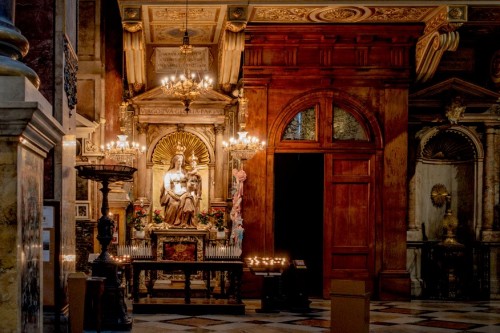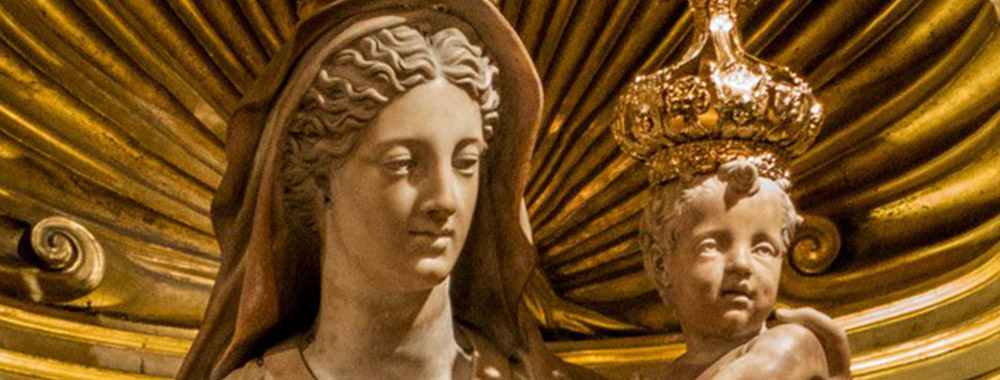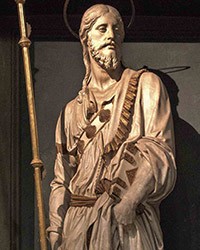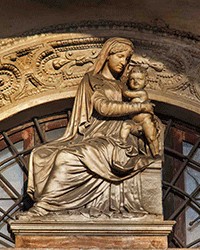
Interior of the Basilica of Sant'Agostino, Madonna del Parto, Jacopo Sansovino

Madonna del Parto, Jacopo Sansovino, Basilica of Sant'Agostino

Jacopo Sansovino, Madonna del Parto, Basilica of Sant'Agostino

Basilica of Sant'Agostino, Jacopo Sansovino, Madonna del Parto

Interior of the Basilica of Sant'Agostino, Madonna del Parto, Jacopo Sansovino

Jacopo Sansovino, Madonna del Parto, Basilica of Sant'Agostino
„Madonna of Childbirth”, such was the name given to the figure of the enthroned Madonna with Child in her lap – a work which still today, next to Caravaggio’s (Madonna of Loreto) is one of the greatest attractions of the Roman Church of Sant'Agostino. Next to the statue, found right behind the entrance door, we will notice tens of letters, baby shoes, stuffed hearts, photographs, and notes, left by women thanking the Virgin Mary for her intercession.
„Madonna of Childbirth”, such was the name given to the figure of the enthroned Madonna with Child in her lap – a work which still today, next to Caravaggio’s (Madonna of Loreto) is one of the greatest attractions of the Roman Church of Sant'Agostino. Next to the statue, found right behind the entrance door, we will notice tens of letters, baby shoes, stuffed hearts, photographs, and notes, left by women thanking the Virgin Mary for her intercession.
At the moment of its creation (1521), the figure was simply known as Madonna with Child and constituted the principal element of the Martelli Chapel found here. It, as well as the niche in which it stands, were designed by Jacopo Sansovino. The work was commissioned to the sculptor during his second stay in Rome, by the heirs of the Florentine merchant, Giovanni Francesco Martelli, which is testified to by the coats of arms placed on the plinths of the columns (griffon) surrounding the sculpture. The aforementioned niche is finished off with a shell and it is surrounded by a portico with an architrave and a triangular tympanum. The fields above the arch are filled with bas-reliefs depicting two allegories – Faith and Hope.
In the middle of the XVII century, the Martelli Chapel was liquidated, leaving the sculpture by itself. It did not enjoy any particular esteem. This heavily antiquated statue depicting the Madonna in a pose reminiscent of pagan goddesses was seen by the spiteful Roman populace as the ancient group depicting Giulia Agrippina the Younger with her son Nero. This can, however, testify to the exceptionality of this work in comparison to other works of that time. The group distinguished itself with its classicist form and size, even giving rise to suggestions that it is an adapted sculpture from ancient times, which were often excavated in Rome during that period. It is no wonder since Sansovino, in his admiration of ancient art made a direct reference (it would seem) to the statue of the enthroned Apollo with a Lyre (Museo Archeologico di Napoli), which was in the past found in the Eternal City. However, that is not all. In his work, we will find inspiration from the art of Michelangelo (The Statue of Moses, sibyls in the Vault of the Sistine Chapel). Similarly to the child, or more appropriately a little boy, shown in a rather equilibristic pose, with one leg placed on Our Lady's knee, and the other on the arm of a chair, once again makes us assume that the artist patterned himself on ancient art (Boy Strangling a Goose, Louvre, Paris).

The figure of Jesus, as opposed to his mother, is full of dynamism and if it was not for the strong grip of her hand, we might have assumed that his rather unsure steps will end in a hard landing. Even more so because he is holding a bird in both his hands – a sign of the passion. Most likely it is a goldfinch, which is characterized by bright red colors on its head, in accordance with the legend used to symbolize blood. The bird was to be bloodied while taking out a thorn from the eyebrow of the dying Jesus Christ.
It was not until the XIX century that the sculpture became an object of particular adoration due to a certain Roman plebian. He often prayed in front of the figure asking for problem-free childbirth for his wife. After the birth of his baby, Leonardo Bracci took care to light an oil lamp in front of the statue every day, while news of this quickly spread. The Madonna was from then on seen as the protector of pregnant women and newborns. On the other hand, her name Madonna del Prato (of Childbirth) is connected with the inscription placed at the base of the tympanum: VIRGO TUA GLORIA PARTUS – Virgin, Your glory is in giving birth.
The statue was quickly surrounded by votive offerings, but its cult also took on a different shape. In 1822 Pope Pius VII announced a 200-day long indulgence for anyone who would kiss the foot of Our Lady, appearing from underneath the marble robe. Most likely, he did not foresee that this would lead to the "removal" of most of its part. Presently the foot covered in silver recalls this form of devotion, widespread in nineteenth-century Rome.
However, not everybody appreciated the sculpture. Ten years after the pope had announced the aforementioned indulgence, the well-known Roman poet Giuseppe Gioachino Belli, whose picturesque statue is found on the Trastevere, wrote in the dialect of the Roman populace (Romanesco), a rather snide, if not to say iconoclastic sonnet entitled The Madonna So Miraculous (La Madonna tanto Miracolosa), which targeted this idolatrous cult. It must be added that Belli was a conservative and a Catholic supporting the pope, although he exhibited a rather strong anti-clericalism and more often than not was very critical of the behavior of the Roman populace. In the following decade, he was employed as the pope’s censor, contributing among others to the formulation of the ban on the works of Shakespeare in the State of the Church. However, in 1833, seeing the faithful lost in devotion, pushing and shoving each other to gain access to the figure of the Madonna, hanging watches, pearls, necklaces, chains, and other less expensive items on it, he concluded that all these votive offerings make her more of a maid than a saint.
In this way, the poet referred to earlier times, when this sculpture was created, and when the Church of Sant'Agostino was a place where Roman prostitutes gathered. It was here that wealthy Roman courtesans came to attend Sunday mass, sitting in places which they had purchased, building chapels and letting themselves buried. And it was perhaps here that, Fiammetta, Tulia d’Argon and Beatrice Penelope, among others, sought consolation and divine intercession.
Many decades have passed – and today we will only see symbolic offerings around the figure.





















